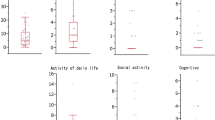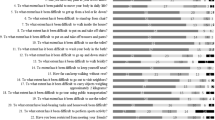Abstracts
Purpose
Locomotive disorders due to musculoskeletal involvement are one of the main causes requiring long-term care services in aging Japan. “Locomotive syndrome (LoS)” is a concept referring to the condition under which people require assistance from others or at risk in future. The object of this study is to examine the relationship between self-reported measure and physician-judged degrees on ADL disability in elder people with locomotive disorders.
Methods
In a cross-sectional study, 711 patients who were aged 65 years old or more were recruited from 49 outpatient clinics and hospitals. We investigated ADL disabilities by self-reported questionnaire (Geriatric Locomotive Function Scale-25: GLFS-25) and physician-judged grading (Locomotive Dysfunction Grade: LDG) and examined the relationship between these two.
Results
We classified the severity of locomotive disability by clinical phenotype into six grades: LDG Grade 1 (N = 77), Grade 2 (213), Grade 3 (139), Grade 4 (162), Grade 5 (78), and Grade 6 (42). The mean of GLFS-25 was 25.9. The mean of GLFS-25 was 5.68 for Grade 1, 14.33 for Grade 2, 22.34 for Grade 3, 35.40 for Grade 4, 43.25 for Grade 5, and 60.24 for Grade 6. Significant differences of GLFS-25 scores were found between adjacent LDGs.
Conclusions
Physician-judged grade of locomotive dysfunction was significantly related to self-reported assessment scale on ADL disability. Physician-judged dysfunction grade is readily administered scale and useful to assess the severity of locomotive dysfunction. Self-reported scale provides precise information on ADL disabilities due to locomotive organ dysfunction and is useful to develop intervention programs.
Similar content being viewed by others
Abbreviations
- LoS:
-
Locomotive syndrome
- LTCI:
-
Long-term care insurance
- GLFS-25:
-
Geriatric Locomotive Function Scale-25
- LDG:
-
Locomotive Dysfunction Grade
References
Cabinet Office, Government of Japan. (2013). Annual report on the aging society. Resource document. http://www8.cao.go.jp/kourei/whitepaper/w-2013/gaiyou/25pdf_indexg.html/. Accessed 12 Dec 2015.
Tamiya, N., Noguchi, H., Nishi, A., Reich, M. R., Ikegami, N., Hashimoto, H., et al. (2011). Population ageing and wellbeing: Lessons from Japan’s long-term care insurance policy. The Lancet, 378(9797), 1183–1192.
Ministry of Health, Labour and Welfare. (2013).The current situation and the future direction of the long-term care insurance system in Japan; with a Focus on the Housing for the Elderly. Resource document. http://www.mhlw.go.jp/english/policy/care-welfare/care-welfare-elderly/dl/ri_130311-01.pdf. Accessed 12 Dec 2015.
Ministry of Health, Labour and Welfare. (2013). Comprehensive survey of living conditions. Table 14 (in Japanese) Resource document. http://www.mhlw.go.jp/toukei/saikin/hw/k-tyosa/k-tyosa13/. Accessed 12 Dec. 2015.
Nakamura, K. (2011). The concept and treatment of locomotive syndrome: Its acceptance and spread in Japan. Journal of Orthopaedic Sciences, 16(5), 489–491.
Yoshimura, N., Muraki, S., Oka, H., Mabuchi, A., En-Yo, Y., Yoshida, M., et al. (2009). Prevalence of knee osteoarthritis, lumbar spondylosis, and osteoporosis in Japanese men and women: The research on osteoarthritis/osteoporosis against disability study. Journal of Bone and Mineral Metabolism, 27(5), 620–628.
Vos, T., Flaxman, A. D., Naghavi, M., Lozano, R., Michaud, C., Ezzati, M., et al. (2012). Years lived with disability (YLDs) for 1160 sequelae of 289 diseases and injuries 1990–2010: A systematic analysis for the Global Burden of Disease Study 2010. The Lancet, 380(9859), 2163–2196.
Nakamura, K. (2008). A ‘‘super-aged’’ society and the ‘‘locomotive syndrome’’. Journal of Orthopaedic Sciences, 13(1), 1–2.
Nakamura, K. (2009). Locomotive syndrome: Disability-free life expectancy and locomotive organ health in a ‘‘super-aged’’ society. Journal of Orthopaedic Sciences, 14(1), 1–2.
Locomotive Syndrome pamphlet (Japanese Orthopaedic Association). (2014). Resource document. http://www.joa.or.jp/jp/public/locomo/locomo_pamphlet_2014.pdf. Accessed 12 Dec 2015. (in Japanese).
Seichi, A., Hoshino, Y., Doi, T., Akai, M., Tobimatsu, Y., & Iwaya, T. (2012). Development of a screening tool for risk of locomotive syndrome in the elderly: The 25-question Geriatric Locomotive Function Scale. Journal of Orthopaedic Sciences, 17(2), 163–172.
Ogata, T., Muranaga, S., Ishibashi, H., Ohe, T., Izumida, R., Yoshimura, N., et al. (2015). Development of a screening program to assess motor function in the adult population: A cross-sectional observational study. Journal of Orthopaedic Sciences, 20(5), 888–895 .
Muramoto, A., Imagama, S., Ito, Z., Hirano, K., Ishiguro, N., & Hasegawa, Y. (2012). Physical performance tests are useful for evaluation and monitoring the severity of locomotive syndrome. Journal of Orthopaedic Sciences, 17(6), 782–788.
Muramoto, A., Imagama, S., Ito, Z., Hirano, K., Tauchi, R., Ishiguro, N., et al. (2013). Threshold values of physical performance tests for locomotive syndrome. Journal of Orthopaedic Sciences, 18(4), 618–626.
Seichi, A., Hoshino, Y., Doi, T., Akai, M., Tobimatsu, Y., Kita, K., et al. (2014). Determination of the optimal cutoff time to use when screening elderly people for locomotive syndrome using the one-leg standing test (with eyes open). Journal of Orthopaedic Sciences, 19(4), 620–626.
Iwaya, T., Doi, T., Nakamura, K., Akai, M., Tobimatsu, Y., Hoshino, Y., et al. (2014). Operational definition of locomotive syndrome. Japanese Journal of the Orthopaedic Association, 88(10), 731–738. (in Japanese).
Iwaya, T., Akai, M., & Doi, T. (2015). Clinical picture of Locomotive Syndrome with disabilities in elderly people. Japanese Journal of the Orthopaedic Association, 89(5), 365–372. (in Japanese).
Tsuts ui, T., & Muramatsu, N. (2005). Care-needs certification in the long-term care insurance system of Japan. Journal of the American Geriatrics Society, 53(3), 522–527.
Clegg, A., Young, J., Ilife, S., Rikkert, M. O., & Rockwood, K. (2013). Frailty in elderly people. The Lancet, 381(9868), 752–762.
Morley, J. E., Vellas, B., van Kan, G. A., Anker, S. D., Bauer, J. M., Bernabei, R., et al. (2013). Frailty consensus: A call to action. Journal of the American Medical Directors Association, 14(6), 392–397.
Kelaiditi, E., Cesari, M., Canevelli, M., van Kan, G. A., Ousset, P. J., Gillette-Guyonnet, S., et al. (2013). Cognitive frailty: Rational and definition from an IANA/IAGG international consensus group. The Journal of Nutrition, Health and Aging, 17(9), 726–734.
Fried, L. P., Tangen, C. M., Walston, J., Newman, A. B., Hirsh, C., Gottdiener, J., et al. (2001). Frailty in older adults: Evidence for a phenotype. The Journals of Gerontology. Series A, Biological Sciences and Medical Sciences, 56(3), M146–M156.
Mitnitski, A. B., Graham, J. E., Mogilner, A. J., & Rockwood, K. (2002). Frailty, fitness and late-life mortality in relation to chronological and biological age. BioMed Central Geriatrics, 2, 1. doi:10.1186/1471-2318-2-1.
Rockwood, K., Song, X., MacKnight, C., Bergman, H., Hogan, D. B., McDowell, I., et al. (2005). A global clinical measure of fitness and frailty in elderly people. Canadian Medical Association Journal, 173(5), 489–495.
Seidele, D., Brayne, C., & Jagger, C. (2011). Limitations in physical functioning among older people as a predictor of subsequent disability in instrumental activities of daily living. Age and Ageing, 40(4), 463–469.
Acknowledgments
We wish to thank Kozo Nakamura, Hiromoto Itoh, Keiji Fujino, Noriko Yoshimura, and Kunihiko Hayashi for their advice and Noriko Kojima for her secretarial work. This study was conducted with the support of the Japanese Clinical Orthopaedic Association. We are also grateful to all of the orthopedic surgeons, their staff members, and those who willingly participated in this study (49 study sites): Matsuzaki Orthopaedics, Yamashita Orthopaedic Clinic, Nasu Orthopaedic Clinic, Hyakutake Orthopaedic Hospital, Morishita Orthopaedic and Rheumatism Clinic, Mori Orthopaedics, Nakagaki Orthopaedics, Takaoka Clinic, Tatsuya Orthopaedic Clinic, Shimizu Orthopaedic Clinic, Mistukaichi Orthopaedics, Nagakura Orthopaedics, Himeno Hospital, Cosmopia Kumamoto Institution for the Elderly, Mukaiyama Clinic, Yoro Orthopaedics, Idota Orthopaedics, Kiyoshi Orthopaedics, Kumamoto Kino Hospital, Sakata Orthopaedics, Minamiakita Orthopaedics, Aomori Jikeikai Hospital, Oyumino Orthopaedic Clinic, Tanikake Hatano Orthopaedic and Rehabilitation Clinic, Matsuo Orthopaedics, Konagai Orthopaedics, Suzuki Orthopaedics, Sugiyama Orthopaedic and Rehabilitation Clinic, Hirose Orthopaedics, Nozomi Orthopaedics, Mizoguchi Orthopaedics, Shiba Orthopaedics, Morifuku Orthopaedics, Yoshimura Orthopaedics, Tomono Orthopaedic Clinic, Horii Orthopaedics, Matsuki Orthopaedics, Yamanaka Orthopaedics, Mochizuki Orthopaedics, Oya Orthopaedic Clinic, Miyake Orthopaedics, Koganei Chuo Hospital, Shimotsuga General Hospital, Haga Red Cross Hospital, Imaichi Hospital, Sano Clinic, and Shiobara National Towa Clinic, Saigo Hospital.
Author contributions
TI conceived and designed the study. AS, YO, and TO performed the study and collected the data. TD, TI, and MA performed statistical analysis of the data and interpreted the results. TI and MA wrote the article.
Funding
This study was supported by a Sciences Research Grant (H20-Choju-G-002) from the Ministry of Health, Labor, and Welfare, Japan. No benefits in any form have been or will be received from any commercial party related directly or indirectly to the subjects of this article.
Author information
Authors and Affiliations
Corresponding author
Ethics declarations
Conflict of interest
The authors declare that they have no conflict of interest to disclose.
Ethical approval
All procedures performed in studies involving human participants were in accordance with ethical standards of the institutional and/or national research committee and with the 1964 Helsinki Declaration and its later amendments or comparable ethical standards.
Rights and permissions
About this article
Cite this article
Iwaya, T., Doi, T., Seichi, A. et al. Relationship between physician-judged functioning level and self-reported disabilities in elderly people with locomotive disorders. Qual Life Res 26, 35–43 (2017). https://doi.org/10.1007/s11136-016-1377-4
Accepted:
Published:
Issue Date:
DOI: https://doi.org/10.1007/s11136-016-1377-4




